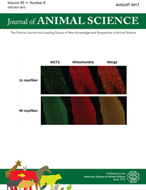-
Views
-
Cite
Cite
G. D. Cruz, J. A. Rodríguez-Sánchez, J. W. Oltjen, R. D. Sainz, Performance, residual feed intake, digestibility, carcass traits, and profitability of Angus-Hereford steers housed in individual or group pens, Journal of Animal Science, Volume 88, Issue 1, January 2010, Pages 324–329, https://doi.org/10.2527/jas.2009-1932
Close - Share Icon Share
ABSTRACT
Even though the concept of residual feed intake (RFI) is well accepted, several questions remain regarding other traits that may be associated with selection for decreased RFI. These include DM digestibility, carcass composition, profitability, and performance. The objective of this study was to investigate the difference in those traits between low- and high-RFI cattle. Sixty Angus × Hereford crossbred steers (296 kg of initial BW) were fed a corn-based finishing ration (1.68 Mcal of NEm/kg, 13% CP on a DM basis) during 2 periods of 60 d each. For both phases, the regression equation fitted without the intercept (not statistically significant) was DMI (kg/d) = 0.0701 × BW0.75 + 2.714 × ADG, r2 = 0.42. The 15 greatest and least RFI steers were classed as high and low RFI groups. There were no differences between low and high RFI groups for days on feed (162 vs. 168 d), slaughter weight (503 vs. 511 kg), HCW (317 vs. 315 kg), LM area (76.5 vs. 77.1 cm2), backfat (1.23 vs. 1.27 cm), KPH (3.1 vs. 3.7%), quality grade (average Choice for both groups), or carcass fat (32.4 vs. 33.1%). Visceral organ masses and abdominal fat were similar for low and high RFI groups (32.25 vs. 31.24 kg and 37.48 vs. 36.95 kg, respectively). These results do not support the existence of major differences in composition and organ mass between low and high RFI steers at slaughter. The RFI grouping had a significant effect on DMI, G:F, and RFI values. Stepwise regression showed that G:F alone or DMI and ADG together explained 98.5% of the variance in cost of BW gain, whereas RFI alone explained only 18%. We conclude that RFI is less useful than G:F as an indicator of feedlot efficiency and profitability.





